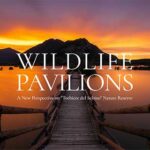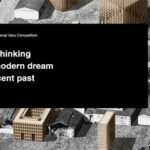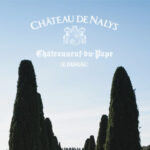With this text, we continue series of articles on Competitions.archi. We will be showcasing the case studies of the projects that were awarded in various architecture competitions.
The main focus of this series is to understand the design process behind all winning submissions. That is why we will be asking all architects and designers ‘ How you won that competition? ‘. We’re curious about their path, from the first draft, the first blueprint to the full-scale plan. We’re also interested to see which solutions had been dropped on the way, what kind of choices had to be made, and most importantly, what was the grand idea behind the project. That is why we will be asking for sketches, drafts and detailed descriptions so that we can fully understand their technique and the process that resulted in the awarded works.
This article is part of Architecture Competitions Yearbook 2020 – where more stories and inspirations like the one below can be found.
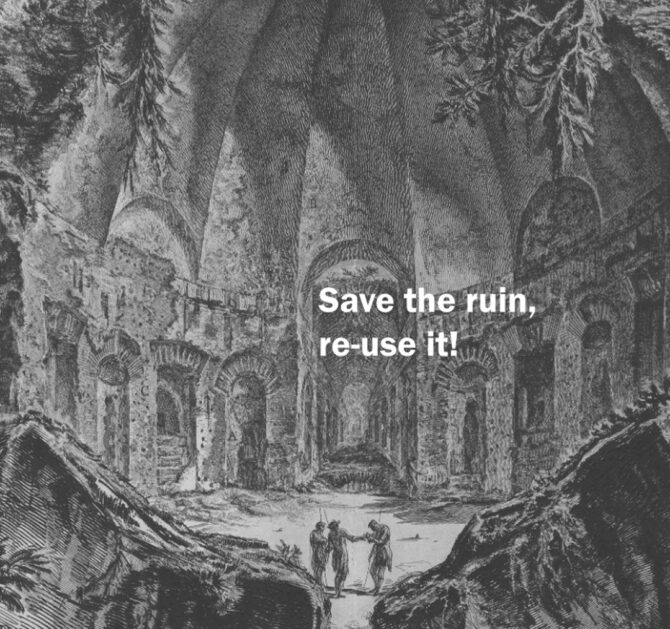
The first approach to the project was a long informal talk started from understanding together the purpose of the competition. We considered it not only in terms of given function but also we were trying to find out the attitude of the intervention in a place like Grottole, for an international competition of ideas. Grottole is a little village in Basilicata in the south of Italy, situated on a hill in the Valle del Basento. Its relationship with the landscape evokes the close city of Matera, where a rural character is extremely expressed by his houses stuck in the rocks that generate a radical way of living. The competition proposes to work on the ruin of the Chiesa Diruta. It is an historical monument of the 15th Century, a reference point for the village of Grottole and a landmark in the Valle del Basento due to its strong position along the perimeter of the hill, just in front of the medieval castle. The unfinished state of the ruin was the specific architectural characteristic of the site. The main purpose of the competition was to reuse the church as an Auditorium and a Civic space for the village and give a new life to the building enouncing the value of the ruins. The first practical approach was a plan and section analysis of the territory. We were analysing historical, civic and important buildings in Grottole with the purpose to find out the relations that the topographies generate into each other. We deemed this type of analysis adequate for a place like Grottole because it is a village on the top of a hill surrounded by Basento landscape and with a complex topography that creates unexpected perspective between the buildings of Grottole. At the same time, focusing on important and historical buildings was an opportunity to discover information about Grottole as a little historical village. In the historical documentation of this rural site, some tales like the one of Sichinulfo Castle (Castello Sichinulfo Grottole – Abufina e Selepino – Be Curious!) sometimes came out and helped to understand the history of the place from a cultural point of view.

Talking about the possibilities that the ruin offered us and studying the site, helped us to understand clearly that the project had to deal indirectly with the landscape and directly – physically with the ruin. We recognized two different ways of touching the massive walls of the church represented by the idea of, complete the body. In this terms the Basilica Palladiana was a useful example manly for the huge wooden roof posed on masonry walls. Moreover, considering the concept of fill the void, the Basilica Palladiana again and Tempio Malatestiano represented “the negative” of this approach, where the existing body is wrapped with a new volume by overlapping a new façade to the old one; revealing by the dialogue of the two parts the essence of the project. We were fascinated by this second approach that gives a new meaning to the ruin and establishes the dialogue between the old and the new. The clarity of this approach particularly convinced us due to the recognisability of the two souls of the building. The references had been significantly useful. They are two clear approaches to intervene on an existing building with long history. On one side, trying to conceive the existence and understand its importance are creative acts. On the other, it requires courage of transforming with a contemporary graft. On one side, there is a more architectural and physical suggestion, while on the other, a strong ideal and cultural position. This work on the references helped us to figure out the main idea as a common base to start drawing the project. Another common experience that we think indirectly helped us during the design process has been a trip to Portugal in 2019. We were sharing the physical experience and thoughts about places, projects, and habits there.
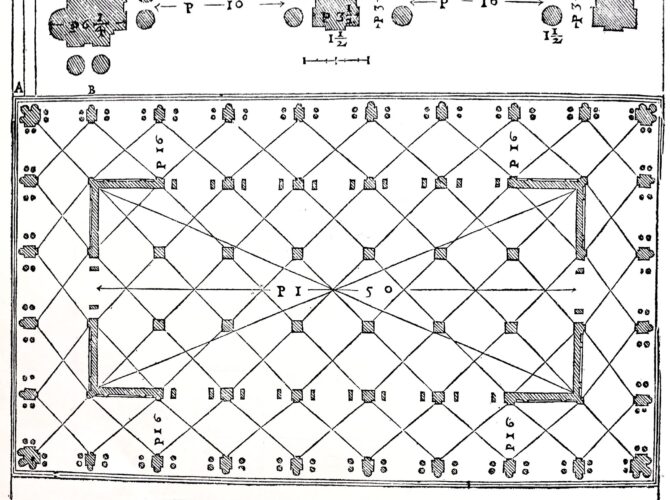
Basilica Palladina – plan
This way of approaching the ruin had to deal with the idea of leaving free the complexity of the volume of the existing church. The nave defines an inside regular volume, instead of the exterior. The body is complex and articulated due to the ground levels changes around the building. This condition immediately helped us to summon the image of a volume that shows
itself from the split on the angle of the main façade. (F01) Another characteristic of the Chiesa
Diruta that particularly influenced the first approach was the massiveness of the walls and their huge masonry construction. Some projects by Portuguese architects like Alvaro Siza, Souto de Moura and Aires Mateus that we experienced together in 2019, were helpful for their plastic approach in terms of language and construction. We ended up with the idea of a white plastic volume that graft the ruin with a contemporary construction of punctual light elements that could make a wall, a surface. We figured out a contemporary pure object in contrast with the renaissance and articulated body of the church. Nevertheless, construction works in analogy with walls defining a clear volume.

Between the church and the lanscape
A main topic of the project was the relationship with the surrounding landscape of Grottole and Valle del Basento. It was the principal object of the site analysis. The most important buildings of Grottole, the main church, the Chiesa Diruta and the Medieval Castle are juxtaposed in strategic point around the hill, erected toward the landscape.
The articulation of a section with a solid and unique block on the north façade, on the side of the village and fragmented and terraced toward Basento, was a way to deal with the two different characteristics of the landscape. The Grottole, solid and compressed volume, contrasts the openness of the Valle. (F02.5) At the same time the interior space is scanned. The main hall of the church keeps its entire height and the space compressed in the transept intersection and in the apse, searching a horizontal relation with the landscape at different levels. The spaces of the ruin, from the nave to the transept, are really defined. We were trying to understand the footprint of each one to realized if they had to live as a sequence of different spaces or conceive them as a unique one. For the strong spatial definition of each one, we tried to treat them as a sequence, both in plan and section. The solution of the dome was a critical choice in the project, due to its geometry and height. It was complicated to integrate the dome volume in the inside space and conserve the idea of an evocative silent unique volume in concept and constructive terms. The development of the section helped us to solve this moment integrating the drum of the dome as the boundary of a panoramic terrace. Instead of use the entire height of the intersection of the axis, we decide to compress the height and change the original volume of the space. We also evaluated to dig and create a terraced stall. We were fascinated by projection trough the landscape but we understood that it would be an invasive intervention and we had the doubt about structure stability as well. The use of the FAQs that ReUse offered was helpful to get the certainty and know how to relate to the ruin from a structural point of view.

The section has been the main tool that helped us to control the relation between interior and exterior space and understand the integration between the new intervention and the existing church. (F02.0-02.1-02.4) At the same time the position of the stage has been discussed as a choice that organise the main hall. Always thinking about the consequences generated with the entrance and the section development, we were trying to make it functional and control the narrative sequence of the spaces such as a way of experience the auditorium, the ruin and the landscape. We evaluated three different possibilities. The first one included the stage in the intersection of the transepts, the second in the apse (in this first two choices we preserved the traditional orientation of the church), and the last one with the stage on the main façade, overturning the direction of the scene.
The turning point has been to integrate the entrances system in this design phase and in particular the pre-existing chapel of Santa Lucia on the north side. We understood from a site visit that the compressed space of the chapel deserved a worthy role. It could create a pleasant atmosphere while entering the building from the village site. It would be more intimate and sequenced entrance in comparison with the one on the main façade and seemed to fit properly to narrow and domestic streets reaching the building form the rural site. The representative entrance instead is located on the lower floor on the south side of the church. The connection of the two entrances generates a distribution band with the east transept as moment of transition. They keep together the entrances and behave as a foyer to access the main hall.

The site visits have been done physically and many times. We didn’t go to visit the site only in the first part of the project. The more useful visits were the ones during the designing process. It was a useful moment to evaluate in site the options we had been discussing before. Even if we liked the different options for the entrances, for example that permit to enter from the central axis of the space on the main façade, we understood that we had to renounce to those ideas. It helped us to come to the conclusions that a more sequenced entrance would be more interesting for the value of the lateral spaces. The site visit has been a moment that changed our ideas but gave us a clearer direction. Enter the main hall from the side fits well with the idea of having two poles, the stage on the north and the landscape in the south, instead of compressing the two moments in the space of de apse.
This polar system has also a positive consequence on the section. As the stage and all the services are stocked in a solid volume that fills the void on the unfinished corner, generating the expectation of the evocative volume of the inside, the view toward the landscape is left free. The first floor also benefits from the position of the stage as it becomes a sort of balcony between the scene and the landscape. The orientation of the stage, the entrance system and the section articulation have been the key choices on which we developed the entire program of the auditorium. The articulation of the program has been drawn in details in three moments concerning the main hall, the section program and the representative entrance and services.
In this first design part, we mainly used 2D Drawings, in particular the longitudinal section, to understand the relation between the ruin and the new intervention. It let us figure out, for example which were the reference horizontal lines suggested by the ruin that we could use to fit the new design and use the section to express as more as possible our intentions.
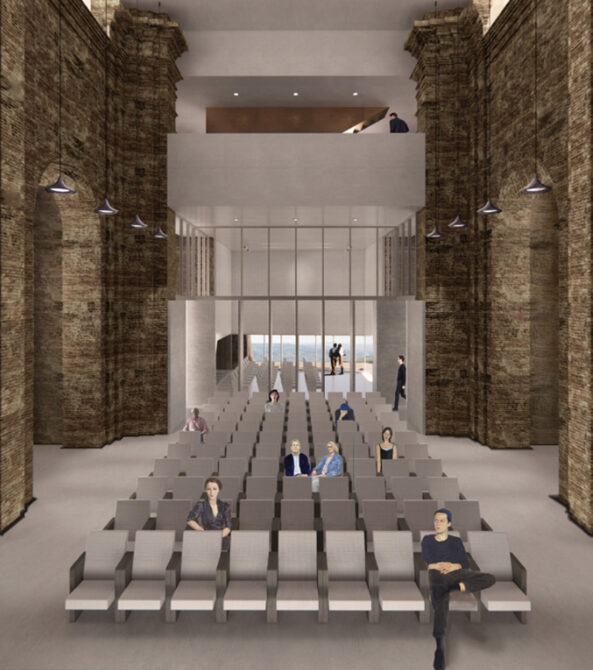
Main Hall
The main hall is characterized by the side entrance, the solid block of the stage, the panoramic point in the apse and the presence of the east transept. The space under the dome’s drum represents the intersection of the two axes and a point of distribution of the surrounding rooms. For this role, the linearity of the hall was compromised. To solve this problem and give dignity to each space in terms of access and functionality, a system of packable walls defined three possible configurations. (F04) This wall generates two entrances to an auditorium and a smaller conference room; both has an independent entrance through the cafeteria in the west transept. The wall is composed by panels that can turn and create a connection between the two rooms giving the possibility to host two different but integrated functions. In the third configuration, by packing all the walls, the entire hall can be used as auditorium for the most crowded events. The most concerning topic was to value the proportion stretched in the height of the transept that gives unity and centrality to the space in the foyer and the cafeteria. The foyer remains free and the central space as the main purpose is distributive. In the case of the cafeteria, the bar carved out its space in the centre as the main feature of the space. The packable wall is the first way to control the distribution. Trying to reduce it gives more space to the two halls and it also permits to conceive the hall as a bigger one. We considered it as a relevant solution, because we already had a foyer even if the “under the dome” space could be organized into the three rooms making that intersection multi-functional.
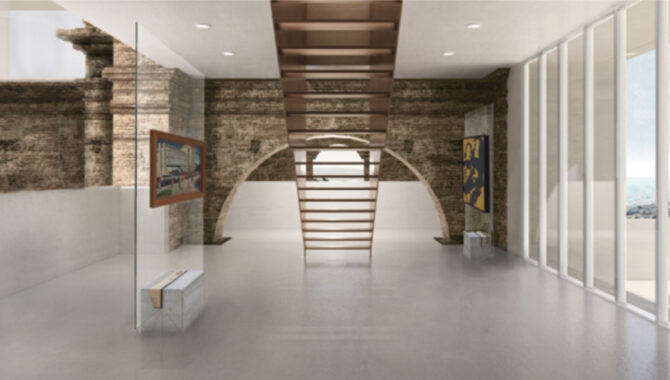
Vertical program
The section generates a sequence of spaces at different height. The location of a stair and a lift was a critical but important moment. We understood that the existing tower could be an opportunity to host a lift system rather than a stair because of its proportions. The project of the lift in Carlos V Palace at the Alhambra in Granada by Torrecillas was a good reference to imagine how a lift, a technical and contemporary object could fit in the void of a massive tower. Concerning the stair, two main topics were relevant for the design. Firstly, we were thinking about putting it inside the hall and designing a monumental stair. This idea did not convince us because the hall had already a defined configuration and we decided to leave it free from other elements that could change the perception of the hall. The two main characters of the space had to be the stage, the ruin and the landscape. Considering the most functional solution for the space, the lift tower had to be connected horizontally with the transept to reach at the first floor the multi-purpose space with a walkway suspended on the old Chapel of Santa Lucia. As the chapel is conceived as an entrance, the stairs suited in the vestibule and it is drawn as part of the lift’s walkway. In this way the character of the chapel as an entrance is emphasized and the vertical distribution system work as one.
The outside stair brings from the enclose and intimate space of the chapel to the walkway that heralds a panoramic view and leads to the compressed space in the upper floor of the transept accessing the multi-purpose space. The stair has been solved by integrating in the design the distribution of the elevator and as an ordinary element. The multifunctional room is an additional space added to the program that can host different kind of function. It has a view on the main hall on one side and an access to a panoramic terrace towards the landscape on the other. The terrace could also work as a space which can expand to the outside the activity of the multipurpose space. From this level a linear central stair leads to the unexpected all-rounded terrace under the drum of the dome. The vertical distribution is conceived as a path through different moments to reach every space. It creates a sequence and enables experience the ruin and relationship with the landscape and the village in different ways, as something to discover. We always thought about the entrance and the exit of each space to understand how the sequence works. In terms of materiality the differentiation of the distributions elements as stairs using Corten helped us to make it recognizable and deal with the materiality of the existing ruin.
Main entrance
The main entrance on the lower floor tries to reuse and give dignity to the more servant spaces on the street “Viale della Resistenza” which runs along the south side of Grottole. The central entrance leads to a stair in the room on the left. The visitors could take the stairs and arrive at the upper floor watching the Valle del Basento. The arrival space is a terrace connected to the transept that has a role of foyer.
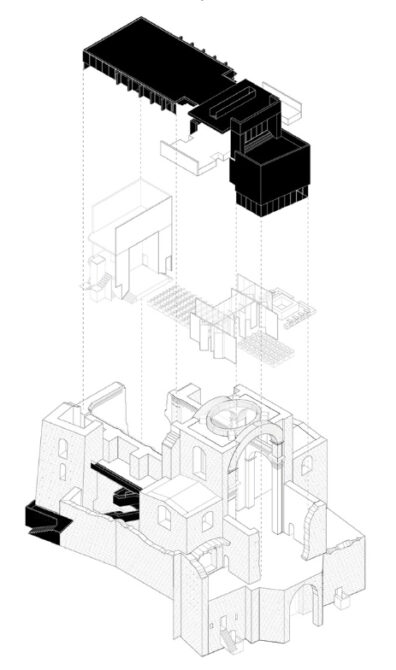
Representation
Our main purpose was to represent the idea in the clearest possible way that would transmit to the readers which were the most important topics of the projects. As we had to deliver only one A1, we had to choose few drawings that could synthesize the entire project. The more technical drawings, as plan and section, try to describe the new and the existing part of the project and their mutual integration as well as show the functionality of the spaces. The details of the existing ruin were important. We were trying to draw them in a way that will enable identification. Furthermore, at the same time they should have had similar graphical quality and importance. This starts with the question, which was the hierarchy between the parts of the drawing? The longitudinal section better explain how the project deal with the ruin, the program, and the landscape, then the transversals ones more useful in detail scale. A precise program was related to the plans to make understand how we worked on the given program and how the function of each space is solved. It was important for us to make the project comprehensible only by reading the drawings. One of the most essential topics was the relationship between the evocative volume and the ruins. The two exterior images have been useful to explain how the project is trying to declare itself strongly in some points and to be more silent from other point of views. The same images try to explain the double scale relationship with the contest, the domestic one of Grottole and the wide one of Valle del Basento. The starting photos for the images had been done with a drone, it turned out to be useful for a place like Grottole. We like the idea of using those photos to represent in the best way the ruin. The interior images represent the two more significant and characteristic spaces of the design trying to express the tension between the new intervention, the ruin, and the landscape. We chose the two spaces that were more important for the program and showed the theme of the design effectively. We decided to add a more schematic part to represent the south façade and in detail the role of the packable wall in defining three configurations. The last scheme was important to explain the concept of the intervention and verify it at the end of the design process. It has been useful trying to synthesize all the process in just three steps, both for the presentation of the project and for us as a final verification. We had the opportunity to add a text of description. It has been an important moment to make understand the narrative of the project and integrate the drawings with the missing information. The other written part we could add was the title of the project. As the project was delivered without the possibility of explaining it and in this terms convince, a precise and effective title was a good way to present the project for a first sight judgment.

If you would like to ready more case studies like the one above please check our annual publication – Architecture Competitions Yearbook. This book is perfect for you if you want to know:
- Whats the secret behind winning submissions?
- What makes a good project?
- How to create an innovative solution to the given problem?
…and much more.
Learn more by clicking the banner bellow.






